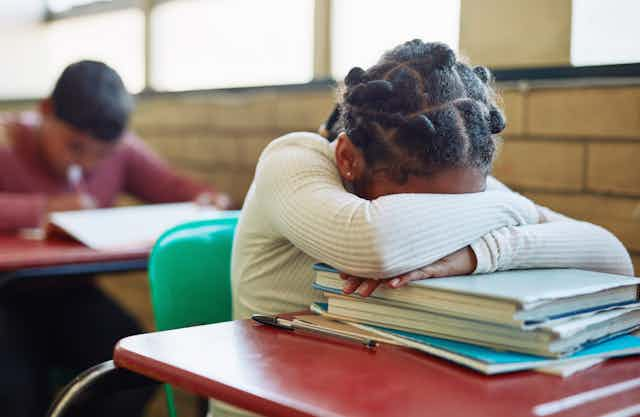Each school year, nearly 3 million K-12 students get suspended and over 100,000 get expelled from school. The offenses range from simply not following directions, to hitting or kicking, to more serious behaviors like getting caught with drugs or a weapon.
And it starts early in students’ education – it’s not uncommon for preschoolers as young as 3 years old to be suspended or expelled from their childcare program.
A big part of the problem has to do with implicit biases. Black students, especially boys, are suspended and expelled at much higher rates than white students. Teachers tend to see the behavior of boys in general and students of color as more difficult, and they respond in harsher ways. This is true even if it is the exact same behavior.
But it’s also important to understand what leads to behaviors that end in suspension and expulsion. As a licensed clinical social worker for over eight years, I’ve worked with children of all ages who struggled at school. Many of them had been kicked out temporarily or permanently for things like spitting, running out of the classroom or fighting. One thing most of these students had in common was their experience of trauma at home and in their neighborhoods.
Childhood trauma
Trauma includes things like child abuse and neglect or witnessing violence at home or in one’s neighborhood. It can lead to challenging behaviors. In my practice, I witnessed how children who saw hitting or heard yelling at home would hit or scream when they got frustrated at school. Or a child who experienced severe neglect might hoard food in their desks or seem detached or hard to connect with.
While researching what leads to school discipline, I found that elementary school teachers report more disruptive behaviors – like arguing and temper tantrums – among children who have reported experiencing more frequent violence, such as adults in the home beating each other up. More disruptive behaviors were also related to more days suspended in the last year.
Among teenagers, colleagues and I found that students who reported being beat up, attacked with a weapon or sexually assaulted also had more problem behaviors at school. They got in trouble more often for cheating, fighting or disturbing class. And, similar to the other study, they were suspended and expelled from school more frequently.
Recent work by other researchers has found this to be true for preschoolers, too. One study of more than 6,000 parents of preschool children found that for every additional type of childhood adversity a preschooler experienced, they had an 80% higher risk of being suspended or expelled. Childhood adversity includes things like witnessing violence in the home and being abused or neglected. The World Health Organization warned that added stress and anxiety for caregivers, on top of lockdown and social distancing measures, greatly increased the risk of experiencing violence at home during the pandemic.
Punishing kids who are hurting
What makes this issue even harder is that children’s behaviors generally don’t improve after being suspended, and the research is mixed on whether suspension helps classmates.
Childhood trauma and adversity is not an uncommon experience. In a 2013 national study of 4,503 kids ages 1 month to 17 years, 41% had been physically assaulted in the past year and over 1 in 10 had experienced maltreatment at the hands of a caregiver. Over a third of American children – 37% – have had an official child maltreatment investigation at some point in their lives.
For a child who has experienced trauma, suspension or expulsion from school may be particularly harmful. As I saw in my clinical practice, being suddenly cut off from teachers and peers can be hard for students who have had sudden losses of other relationships in the past, such as a parent being deported or incarcerated. Suspension and expulsion can also disconnect students from a potentially safe environment and lead to more time in an abusive or dangerous environment, as well as loss of trust in the school system in general.
[Get the best of The Conversation, every weekend. Sign up for our weekly newsletter.]
New discipline policies
Many schools are now incorporating what’s called a “trauma-informed lens” into their training and education policies.

Being “trauma-informed” involves understanding the effects of past trauma and recognizing the signs and symptoms of trauma. Trauma-informed approaches also focus on providing mental health or other resources to address traumatized students and making efforts not to re-traumatize them. This may include training teachers to understand and recognize what trauma looks like, and making referrals for students to mental health counselors. Incorporating an understanding of racial trauma, or the painful effects of racism and discrimination, can also help combat bias and racial inequities in schools.
Knowing the link between past trauma and the difficult behaviors that get kids suspended and expelled, schools can revise their discipline policies to better support young students. The 2015 documentary “Paper Tigers” shows how discipline policies can change after taking a trauma-informed approach. Over a dozen states are trying to do away with expulsion entirely, particularly in preschools.
Trauma-informed approaches can flip the script on “zero-tolerance” policies by going from a “no questions asked” approach to one where teachers try to figure out what is behind the student’s behavior.
Without these approaches, I believe schools risk further hurting children who have already been hurt.

